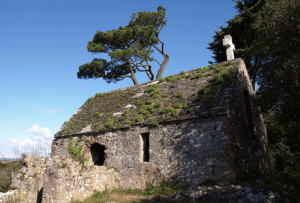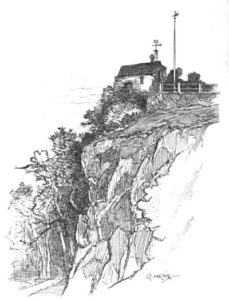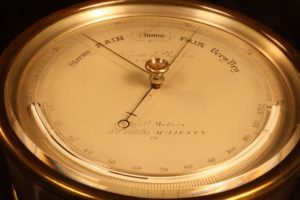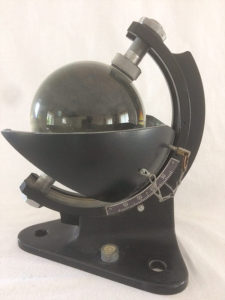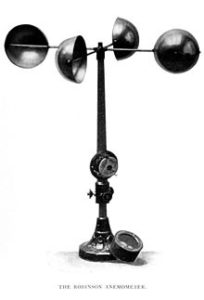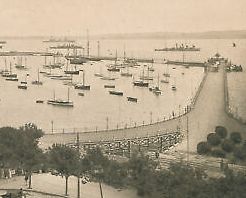We all know St Michael’s Chapel opposite Torre Station. Less well known are the other ruins next to the chapel. However, this site was once vital to Torquay’s tourism industry.
This graffiti-covered wall is much later than the Chapel and is all that remains of the Borough Meteorological Observatory which operated on the hill between 1888 and 1902. The Observatory was initiated and maintained by Torquay Town Council, under the supervision of the Royal Meteorological Society and during its short life was operated by Alfred Chandler.
The Observatory was sited on the hill for its uninterrupted views and built on solid limestone to prevent vibration at the summit of the quarry. The ground level was 276 feet, while the top of the building 286 feet above sea level. It was designed in 1888 by J Hallwith, while the erection of the Anemometer and a larger ‘computing room’ by HA Garrett came in 1894.
There was a slight error in the foundations of the original building, so the Observatory was not quite true astronomical North and South. Nevertheless, it was vital that the instruments were all fixed in a true direction. And it was one of a pair of stations, with another set of instruments on Cary Green – these needed to be fenced off to prevent interference from enthusiastic and often inebriated Strand visitors.
The complicated and sensitive instruments were maintained with the assistance of the Chapel Grounds Gardener. They included sunshine recorders, a Solar Thermometer by Negretti and a Snowdon Rain Gauge. In 1894 an Anemometer was installed which registered the velocity and direction of the wind and the time of its various changes. This was the invention of Dr. Robinson of Armagh in which four hemispherical cups of five inches diameter, fixed on twelve inch arms, revolved with the pressure of the wind. Duplicates of some of these instruments were also at Cary Green.
It was between 1850 and 1900 that talented instrument inventors and manufacturers had organised, standardised and systematised weather observation in Britain. In the 1850s and 1860s publications containing detailed summaries of these observations appeared, and by 1880 across the nation there were observations of pressure, temperature, wind, sky state, current weather, and visibility. These were being taken at specific times of the day and immediately transmitted by electric telegraph to central offices where they were plotted on maps. Responsibility for collating observations and analysing charts lay with the organisation that became known as the Met Office.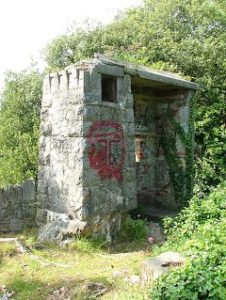
In its early days the need for rapid and accurate weather information was of most use to the sailing community. But for the communities of Torbay, there was another vital imperative. Torquay was, at the time, presenting itself as Britain’s most elite holiday resort and so the findings of the Observatory were of real importance for the town. We had good weather and we needed to tell everybody about it as soon as we could. There was acute competition for visitors… and for the right ‘type’ of visitors.
And we were very good at presenting our unique attributes to the nation and the world. In 1897 Plymouth’s Meteorologist H Prigg acknowledged Torquay’s promotional success. He wrote, “It is undoubtedly by these means (the system for distributing by telegraph the daily weather at Torquay) that the Climate of Torquay is so widely known and so fully appreciated.”
Each day, at 9AM and 4PM, Alfred Chandler and his associates would carefully enter the information provided by his equipment, check it again, make computations and then distribute the data.
Daring the latter part of the nineteenth century each year our Observatory issued two thousand five hundred ‘Afternoon Reports of the Weather’ by Telegram which were published daily in newspapers under the titles ‘Weather at the South, Torquay’ or ‘Weather at the Sea-side Resorts.’
These notices appeared in: The Newcastle Chronicle; Glasgow Mail; Sheffield Telegraph; Yorkshire Post; Liverpool Post; Liverpool and Manchester Journal of Commerce; Birmingham Post; Birmingham Gazette; Bradford Observer; and the Bristol Times & Mirror; the London Standard; Daily Chronicle; Western Morning News; The Western Daily Mercury; and the Queen Newspaper.
The newspapers were a vital way of promoting Torquay to those with the means to holiday – The Birmingham Post had a daily circulation of 27,000, while The London Standard was selling more than 250,000 copies.
Weekly, monthly, and annual reports on our weather were also published by: The Royal Meteorological Society; the Meteorological Office; Symons’s Meteorological Magazine; British Rainfall; the Torquay Directory; the Times; the Standard; The Natural History Society; and the Transactions of the Devonshire Association. A Special Report was prepared on ‘The Climate of Torquay’ and published in the ‘Health Resorts of Europe.’
Keeping locals and visitors well informed, daily reports were also placed on the Strand, at the Museum, and sent to all Torquay’s principal hotels and boarding houses.
The Observatory was in itself a tourist attraction and many visitors came to view these new wonders of technology and to take way printed reports.
But technology moves on and requires more space. So, in 1902 the Observatory closed and the equipment was moved to the end of Princess Pier.
But never forget that for those 14 years a forgotten ruin in the woods was Torquay’s main way of advertising itself to the world.
(Thanks go to Derek Harper for the photo of the ruins)

You can join us on our social media pages, follow us on Facebook or Twitter and keep up to date with whats going on in South Devon.
Got a news story, blog or press release that you’d like to share or want to advertise with us? Contact us



